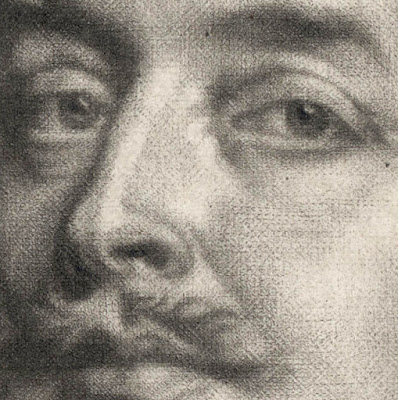Robert
Williams (fl.1680–1704)
“Sir Edward Littleton”, either 1640–1641 (the National Portrait
Gallery attributes the dates of the print as 1640–1641 [see https://www.npg.org.uk/collections/search/portrait/mw131703],
but these dates lie well before the dates that this printmaker was active
according to the British Museum) or c.1680–1704 (BM attrib.),
mezzotint after the painting by Anthony
van Dyck (1599–1641), printed and produced by John King (“at the Globe in
the Poultrey” as inscribed on the plate) in London.
(Note that the BM describes
both of their first state impressions of this print as published by the artist [Robert Williams], but this information is inconsistent
with the publication details inscribed on the plate in its first state. In the
second sate (as shown in the impression held by the NPG [see URL above] the
publisher was Robert Williams as inscribed on the plate.)
Mezzotint on laid paper trimmed to the image borderline and backed
with a support sheet.
Size: (sheet) 33.9 x 25.2 cm
Lettered on plate in two lines below the image borderline with the
name of the sitter, “Sr. Edward Littleton …” and his titles (”Lord Chief Justice
of [the] Common Pleas …”; “Lord …”; “Baron …”; “Lord Keeper of the Great Seal.”
Lettered on plate below the title: (left) “Ant. Van Dyck Eques
pinxit”; (centre) “Printed & Sold by [J]ohn King at the Globe in the
Poultrey”; (right) “London.”
State i (of iii?) before the erasure of publication details of John
King and the substitution of Robert Williams as publisher.
Chaloner Smith 1883 33.I (John Chaloner Smith 1883, “British
Mezzotinto portraits from the introduction of the art to the early part of the
present century”, 4 vols, London)
The British Museum offers the following description of this print:
“Portrait three-quarter length standing facing front, wearing cap,
satin robes with fur edges, lace ruff and necklace, with text below; after Van
Dyck, first state.”
Condition: a very rare, first state, strong impression with very
little sign of wear to the plate and the guidelines for the lettering are still visible. The sheet is in excellent condition (i.e. there are no tears, holes,
folds, stains or foxing), trimmed on the image borderline and laid upon a
support sheet of archival (millennium quality) washi paper.
I am selling this rare high quality impression for AU$192
(currently US$144.81/EUR121.02/GBP107.03 at the time of posting this listing)
including postage and handling to anywhere in the world.
If you are interested in purchasing this mezzotint of a grand man
(with more than a touch of self-importance I think) who was a politician, judge, the Chief Justice of the Common Pleas and Lord
Keeper of the Great Seal, please contact me (oz_jim@printsandprinciples.com)
and I will send you a PayPal invoice to make the payment easy.
This print has been sold
Mezzotints are inevitably rich in velvety dark tones. This is
because the process begins with a roughened plate that would only print black
at the initial stage and requires careful smoothing of the pitted plate surface
with a tool called a burnisher to create light tones when the plate is printed.
Even in the lightest areas of this portrait, for instance, traces of the
original pitting of the plate are still visible. From a personal standpoint,
this velvety richness makes mezzotints tactilely appealing. In fact, I have to
restrain myself from touching the very delicate surface that would be damaged
from such exploration.
Mindful that mezzotints have tactile appeal, Williams’ choice of
mezzotint to render this portrait of a grand gentleman seems very appropriate
to me. The reason has nothing to do with me putting my big paws on the chap’s
face, but rather that the mezzotint surface seems to simulate the lush “feel”
of his gown’s fabric. Indeed the pictorial and physical equivalence is so
appealing that my instinct—the primal beast within—wants to reach out and to touch
the print, even if the urge is constrained.
For those interested in the sitter for this portrait, Edward
Littleton (aka Lyttleton of Mounslow) (1589–1645), he was the Chief Justice of
North Wales; see http://www.wikiwand.com/en/Edward_Littleton,_1st_Baron_Lyttelton.








No comments:
Post a Comment
Please let me know your thoughts, advice about inaccuracies (including typos) and additional information that you would like to add to any post.